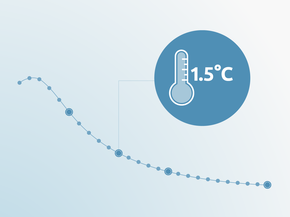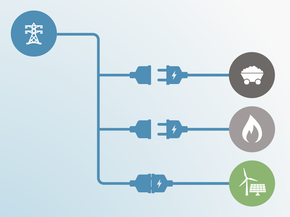Current Policy Projections
Economy-wide
With policies implemented as of September 2017, Canada will reach GHG emissions excluding LULUCF of 693–725 MtCO2e in 2020: an increase of 16–22% from 1990 levels. In 2030, emissions are projected to increase by 7–30% above 1990 levels to 636–775 MtCO2e. Some of the new policies included in the current policy projections are an emissions trading system in Ontario, Alberta’s Climate Leadership Plan, British Columbia’s Clean Energy Act and Quebec’s Eco performance programme for industry.
Canada’s emissions have shown an upward trend from 1990–2007, reaching at 732 MtCO2e in 2007. At the beginning of the financial crisis of 2008/9, emissions dropped significantly. In the period from 2010–2013, emissions started to increase again but showed a short decline in 2014 and 2015. However, with currently implemented policies, emissions could either continue to decrease—or follow an upward trend—depending on GDP growth and the development of oil and natural gas prices.
In 2016, Canada published the Pan-Canadian Framework on Clean Growth and Climate Change[1] to effectively combat climate change and move its economy away from fossil fuels (Government of Canada, 2016c). Of central importance in this framework is a mandatory carbon pricing plan, which requires all Canadian provinces and territories to either introduce a cap and trade system, or an explicit price-based system like a carbon tax or a carbon levy and performance-based emissions system by the end of 2018 (Government of Canada, 2016d). The enabling act for a federal backstop system is under consultation (Government of Canada, 2017a). Originally slated for implementation in 2018, the federal backstop carbon price will go into effect in 2019. By 1 September 2018, provinces and territories must confirm their plans to adopt carbon pricing systems. After this, the system will be assessed for compliance with the federal standard. For provinces and territories that do not adopt a carbon pricing initiative by the end of 2018 or fail to meet the benchmark, the federal backstop system will go into effect on 1 January 2019 at the price of C$20/tCO2e (US$15/tCO2e) (Environment and Climate Change Canada, 2018b). The federal benchmark or floor price will gradually increase to C$50/tCO2e by 2022.
This is a positive development that could result in emission reductions. Carbon pricing is already in place in four Canadian provinces (Alberta, British Columbia, Ontario and Quebec), covering over 80 percent of the population (Environment and Climate Change Canada, 2018a). The range of carbon prices across existing initiatives globally is very broad; spanning from less than US$1/tCO2e to US$140/tCO2e with about 75% of the covered emissions priced below US$10/tCO2e (World Bank, 2017). The 2019 Canadian price is high in comparison and becomes increasingly ambitious towards 2022.
The Pan-Canadian Framework also proposes complementary actions to further reduce emissions across the economy and also suggests measures to build climate resilience, accelerate innovation, support clean technology and create jobs (Government of Canada, 2016c). One such measure is the Low Carbon Fund (Environment and Climate Change Canada, 2017b) which will provide C$2 billion (or approx. US$1.6billion) to support projects that contribute to meeting Canada’s climate targets. The fund has two components: (i) C$1.4 billion will be allocated to support the leadership commitments from provinces and territories on their emission reduction priorities and the commitments they outlined in the Pan-Canadian Framework, (ii) C$0.6 billion will be available for provinces and territories, municipalities, indigenous governments and organisations, businesses and both not-for-profit as well as for-profit organisations to undertake projects that reduce Canada’s GHGs and contribute to clean growth.
A further reduction of 19% from the current policy pathway is expected from the measures listed in the Pan-Canadian Framework for the electricity sector (this includes the accelerated phase-out of traditional coal-fired plants), buildings, transport and industry sectors. The CAT estimates that under these planned policies, Canada would reach GHG emissions excluding LULUCF of 569 MtCO2e, in 2030—which roughly falls in the middle between both interpretations of the NDC target. The CAT would rate the planned policies projection “Insufficient”. However, recent analysis by Energy Innovation (EI) and the Pembina Institute suggests that the gap between planned policies and the NDC target (without relying on LULUCF sinks) might even be larger than expected by the government (Energy Innovation and Pembina Institute, 2018).
Canada is also taking actions to reduce HFC emissions. In October 2016, Canada signed the Kigali Amendment to the Montreal Protocol and proposed new regulations to substantially lower HFC emissions (Government of Canada, 2016d). This is a significant move, as HFC emissions in Canada increased tenfold from 1990 to 2012.
Also, Environment and Climate Change Canada (ECCC) prepared a strategy in 2017 to reduce Short-Lived Climate Pollutants (SLCPs) (Environment and Climate Change Canada, 2017c). This strategy aims to complement the actions outlined in the Pan-Canadian Framework for SLCPs mitigation. Canada’s revised NDC also mentions that Canada is taking actions to reduce SCLPs as they contribute locally to Arctic warming. The strategy by ECCC includes enhanced domestic mitigation and scientific work, engagement with the international community, improved coordination between ECCC and the Canadian Government’s activities on the subject as well as collaboration with provincial and territorial governments.
[1] The province of Saskatchewan has not adopted the Framework; provinces have the flexibility to design their own plans to meet their emission reduction targets.
Energy supply
A stringent performance standard for new coal-fired power plants came into force on 1 July 2015, limiting emissions intensity to 420 tCO2/GWh. The standard also applies to plants that have reached their useful end of life. In general, this means ageing, ~50-year old units - the first of the currently operating power plants commissioned before 1975 - will reach the end of their useful life after 2020, and will therefore not be subject to the performance standard until then. Given this age profile, and the current poor investment environment for new coal power, the performance standard will not contribute to any significant emissions reduction below business as usual by 2020.
In November 2016, Canada announced it would amend its existing coal-fired electricity regulation and accelerate the phase out of traditional[2] coal-fired power plants by 2030 (Government of Canada, 2016e). Since the phase-out may pose challenges for some provinces, the government has indicated that it is willing to negotiate the terms with the provinces still generating electricity using coal: Alberta, Saskatchewan, Nova Scotia and New Brunswick.
In fall 2017, Canada co-founded the Powering Past Coal Alliance to help accelerate clean growth and climate protection through the rapid phase-out of traditional coal-fired electricity (Government of Canada, 2018). In February 2018 the Minister of Environment and Climate Change announced amendments to existing regulations to phase out traditional coal-fired electricity in Canada by 2030 as well as new greenhouse gas regulations for natural-gas-fired electricity (Environment and Climate Change Canada, 2018c).
Despite this phase-out of traditional coal-fired power plants, other developments in Canada suggest that this does not imply a total phase out of all coal-fired power plants. Saskatchewan’s Boundary Dam CCS project is the world’s first and largest commercial-scale coal-fired CCS project. It has the nominal capacity to capture 90% of its GHG emissions, which amounts to around 1 MtCO2eq/year (Government of Canada, 2016b). While some of the CO2 will be stored directly, most of it will be used for enhanced oil recovery which means it will also not be emitted back into the atmosphere (Global CCS Institute, 2016). The CCS unit has captured almost 1.5 million tonnes of CO2 between the start of its operation in October 2014 and March 2017 (Global CCS Institute, 2016). The project cost a total of C$1.5 billion, including C$240 million in government funding (MIT CC&ST, 2016). Canada budgeted C$1 billion in 2016 and made a commitment of C$2.37 billion in 2017 over four years for clean technology industry. The government also announced an additional C$21.9 billion over 11 years for green infrastructure (David Suzuki Foundation, 2017).
We note that the National Energy Board (NEB) published energy supply and demand projections to 2040, including a breakdown of electricity generation that differs from that of the Seventh National Communication (National Energy Board of Canada, 2017). While the NEB electricity generation projections include noteworthy deviations from the projections upon which our assessment is based (e.g. 22 TWh more from coal and coke and 70 TWh less from natural gas in 2030), we have not modelled them as a separate emissions pathway as the resulting emissions fall within that of the existing current policies pathway.
[2] Traditional coal-fired electricity does not use carbon capture and storage (CCS) to capture carbon dioxide and store it.
Transport
In November 2016, the Canadian government also announced that it will develop clean fuel standards, in consultation with provincial and territorial governments, to reduce emissions from fuels used in transportation, buildings and industry (Government of Canada, 2016d). Canada has various policies in place to reduce emissions from the transport sector. Fuel economy standards for light and heavy-duty vehicles are aligned with federal-level regulations in the US. Canada has also implemented a regulation requiring a renewable fuel content of 2% for diesel and 5% for gasoline. In October 2014, Canada issued a notice of intent to develop GHG emission reduction regulations for heavy duty vehicles post 2018. The regulations will be harmonised with US EPA Phase 2 GHG regulations[3] and the target date for publication is winter 2017/18 (Government of Canada, 2017a; TransportPolicy.net, 2017).
[3] At the time of writing, the EPA has not announced any changes to its heavy-duty vehicle GHG regulations.
Further analysis
Latest publications
Stay informed
Subscribe to our newsletter






